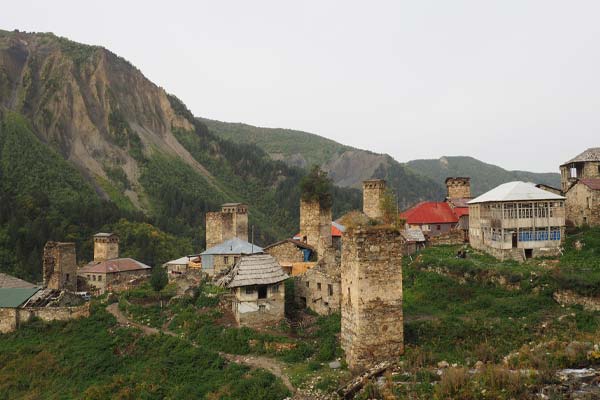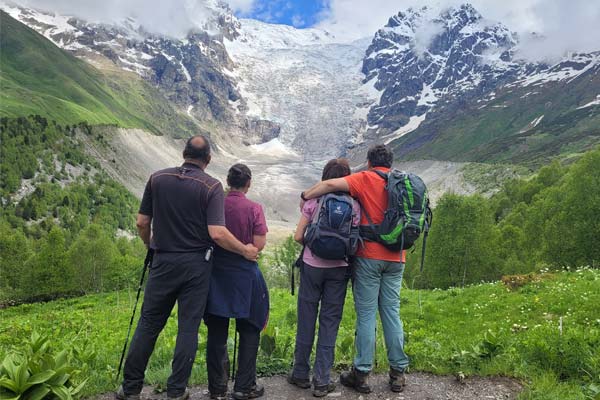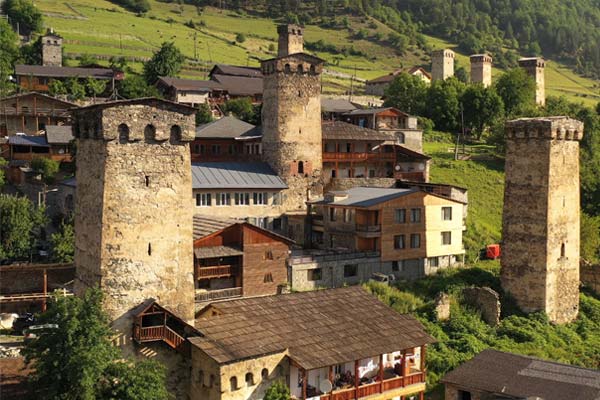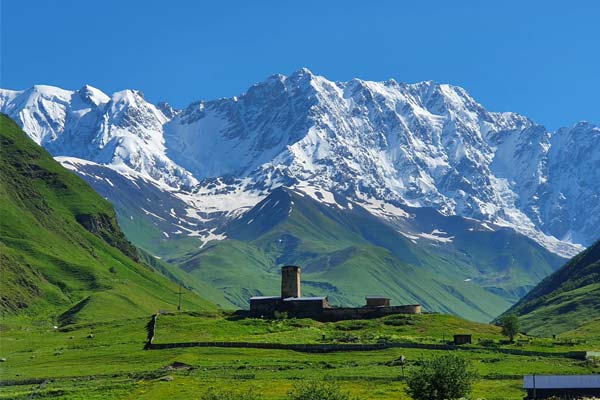|
Adishi Adishi is a small, compact and very interesting village in the upper part of Svaneti. Interesting because of its secluded location, thousand-year-old fortified towers, four different churches with unique frescoes from the 10th and 12th centuries, and last but not least because of the oldest gospel book in Georgia, dated 897, known as the "Gospel Book of Adishi". Location The village is located 30 km from Mestia in the direction of Ushguli, at an altitude of 2,040 m above sea level, on the right bank of the Adishis-Chala River. The name Adishi is written as Hadishi in the local language, but the name Adishi is more common. How to get to Adishi There is no public transport to Adishi. There are private taxis from Mestia or Ushguli, and a return trip costs around 40 euros per car. The road after the turnoff from the main road is in poor condition and you will need a four-wheel drive vehicle. For hikers, there are several routes that lead to Adishi. About Adishi There is written information about Adishi from the 10th century, but the village is certainly much older. Adishi used to be a large community with 5 villages, but only one village has survived. Other settlements were destroyed by various avalanches, landslides, etc. and were never rebuilt. Only ruins of these former settlements can be seen today. Adishi today consists of 13 fortified towers and about twice as many houses. The number of inhabitants varies greatly between summer and winter. After snow, or even after a heavy rain, the only road to the village, about 9 km. The road to the village is closed for a long time and sometimes takes a long time to be cleared, especially in winter because of the danger of avalanches and the generally difficult terrain. As there is currently no school, kindergarten or hospital in the village, most families try to leave in September, before the schools start and before the first snow arrives. Therefore, from 60 to 70 people in summer, about 20 people stay in the village in winter. Throughout Svaneti, you can tell who comes from which village or commune by their surname. In Adishi there are mainly Kaldani and Avaliani. The special features of Adishi In addition to its location and fortified towers, Adishi has four different churches and an Evangeliar. In addition, the 9 km long glacier in the valley and a peak are named after the village. Gospel of Adishi This is a Georgian manuscript written in the monastery of Shatberdi, in the southern part of historical Georgia. It is dated 897, making it the oldest dated Georgian Gospel. The Gospels are written on parchment in the Georgian Asomtavruli script, in two columns per page, and the first five pages are decorated with illuminations. The leaves measure 26 × 18.8 cm. The redaction is unique and differs literarily and grammatically from later Georgian redactions of the Gospels. Since the 16th century, the Gospels have been kept in Adishi. This is how they got their name. Today the Gospels are exhibited in the Historical Museum of Mestia. Church dedicated to the Saviour Jesus Christ - 11th-12th century. Size: 6.55 X 5.2 metres The Jesus Church of Adishi stands in the cemetery at the upper entrance to the village and dates from the 11th-12th century. Next to it is a small open-sided bell tower built much later. The church was painted both inside and out in the 12th century, but only fragments of the façade paintings remain. Inside, however, the frescoes are well preserved. There is a fresco of Jesus on the altar and scenes from the New Testament and individual saints on the sides. The Gospels of Adishi were kept in this church. At present you can see different icons from the 11th, 12th, 13th, 14th, 16th and 17th centuries in the church. The Church of Jesus and other churches in Adishi are closed and you have to ask the locals to open them. Church of St George (JGRAG) - 10th century The small basilica-style church of St George stands at the southern end of the village, on a small hill, and is notable for the frescoes on its northern façade. The church itself dates from the 10th century and the frescoes in and around the church date from the 11th and 12th centuries. Frescoes The northern façade depicts the holy warrior St George on a white horse, with St Theodore behind him. Interior The interior of the church is completely painted and most of the scenes are dedicated to St George. Jesus is on the altar, with Mary and John the Baptist at his side. In the lower register are the Fathers of the Church: St Basil, St John Chrysostom and another saint whose image is not recognisable. On the north side there is a miracle of the dragon of St George and a rescued princess. On the south side is another miracle of George with rescued boys. On the western side is the coronation of St George and St Theodore by Jesus. In general, the frescoes of St George's Church in Adishi are of a very high artistic standard and are among the most important frescoes in the country. In Swanetian, George means JGRAG, which is why this church is also called JGRAG. Archangel Church of Adishi - 11th century Size: 4.9 X 4.2 m At the north-eastern exit of the village, up the hill, is another 11th century church dedicated to the Archangel, a few metres from the village. There used to be another village here, Zagari. The outer walls of the church of the Archangel were badly damaged and needed urgent restoration in recent years. After the restoration, the church's valuable frescoes were also preserved. Fresco painting The exterior façades were also painted, but only a small fragment can be seen on the southern façade. Inside, some of the frescoes have been preserved. The altar depicts Jesus with Mary and John the Baptist. On the south side, three evangelists can still be seen. Another fresco on the south side is the "Adoration of the Child Jesus by the Magi", the scene continues on the north wall, but it is hard to make out. Also in the church are the scenes of the Resurrection, the Baptism and the Annunciation. These frescoes are from the 12th century and their preservation is very important for the region as well as for the whole country. In 2006, the Archangel Church of Adishi received the status of "Cultural Monument of National Importance". St. George's Church "JGRAG Litschanischi" - 11th century Size: 4,9 X 4,2 m Another St. George's Church, is located in 4 kilometres from the village, in the direction of Adischi glacier. There used to be another small village here. The church had the shape of a basilica, but due to later, low-quality additions it has partially changed its shape. The church dates back to the 11th century and has a special significance for locals, because the war flag with St. George's cross used to be kept here. This is where the name JGRAG Litschanischi, (George with the Flag) comes from. It is also believed that families who do not have a son and come to this church to pray will later have a son. To honour the church and its special significance, the folk festival "Litschanischi" was introduced centuries ago. On this day, many people, especially from Svaneti, but also from other parts of the country, come to honour St George. A church liturgy is performed and then celebrated together. Five families from the village of Adishi, who change every year, are responsible for the logistics, but the families who pray for a son to St George also bring something, usually a chicken or a lamb. The families who have increased their prayers from previous years do not come empty-handed either, and the church is the scene of a very convivial celebration. There are some tall tree poles by the church. These are also brought into the church by the faithful. Flags of different colours are hoisted on the poles during the festival, emphasising the importance of the church in connection with the former war flag. The festival is held every year on the Thursday following 28 July. Adishi Glacier The glacier is about 8 kilometres from the village and can be seen from a short distance on the Adishi-Kala trail. The glacier is about 9.5 kilometres long. The lowest point is 2,380 metres above sea level and the highest point is 3,800 metres. The Adishi-Kala River has its source at the Adishi glacier and flows into the Enguri river. Adishi Peak The peak above the Adischi glacier is 4,290 metres high and shares its name with the glacier. To the left is the famous Tetnuldi (4,858 m), recognisable by its distinctive pyramidal shape.
from 1,750 EUR |






